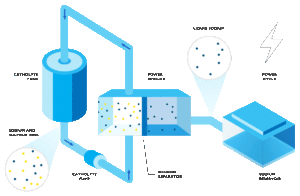Is there room for more “alternative” grid battery chemistries? – Rethink Energy Issue 129 –
To view all of Rethink Energy’s weekly reports, request a free trial or subscribe here. Read the full article by Peter White below.
Yet another “alternative” chemistry battery player has emerged this week, called Enlighten Innovations, which previously operated in low Sulphur fuel oil markets – and it is pushing a Sodium Sulfur system, similar, but not identical, to the technology used in Japan by NGK.
The key to this new system (which is called NaSICON) is a catholyte that contains sodium and sulfur ions dissolved in a solvent and using a special NaSICON separator which contains the sodium.
Enlighten says that the engineering phase of the product is now complete and a protype unit is under construction rated at several hundred KWh, which should be in operation by H1 2022 after which it will move to commercial-scale cells and seek potential strategic partners. It will have to find some big ones.
Sodium Sulfur (NaS) Batteries were originally developed by Ford Motor Company in the 1960s and later that technology was sold off to Japan’s NGK which uses them for stationary applications on the grid. The big issue with that system was the need to keep it at high temperature all the time, between 300°C to 350°C. But they have now been installed widely in Japan and in partner countries at almost 200 sites.
Enlighten claims it has been granted patents on its process, and that it offers a lower LCOS than lithium ion batteries. It claims the cost actually decreases as duration increases, though it is not clear how. Enlighten says its LCOE and LCOS are 48% and 55% lower than lithium-ion solutions, respectively. That’s about 12 to 18 months progress for lithium ion batteries, so it had better move fast.
It’s tech team is based in Denver, Colorado but the company is from Canada and will build a pilot plant in Fort Saskatchewan, Alberta.
“The flexibility of our storage technology at commercial scale across a broad spectrum of use cases, from intra-day energy shifting to durations approaching seasonal storage is exciting. Flexible energy storage solutions will help to capture value as electricity markets evolve rapidly to accommodate the increased penetration of renewables” said Enlighten VP Dr Steve Hughes.
The NaSICON system uses a catholyte, a solution that contains both sodium and sulfur ions. During charge, sodium ions are transferred the NaSICON separator, which has the effect of producing liquid sodium. During the discharge cycle, liquid sodium is converted back to sodium ions. A catholyte is an electrolyte which also behaves as a cathode in an electrochemical cell.
To us this technology is very late to the party as there are already a number of alternative chemistries which are vying with lithium ion chemistries for grid storage. Lithium has the advantage of being well established in the Electric Vehicle space, and has a global R&D spend off the charts. The chances are, that even if it is not the best technology a lithium chemistry will win most installations, though some still worry about thermal runaway.
However if a significant industrial partner backs one of the other technologies, it is more likely to get into play well BEFORE lithium ion falls off the LCOS charts, as volume makes it cheaper and cheaper and better and better. We have documented in the past few weeks how ESS has built an Iron Flow battery and partnered with Softbank’s SB Energy for some huge orders, and how EnerVenue has cut a deal with Schlumberger in Nickel Hydrogen batteries, and how Form Energy has come out of stealth with an iron oxide battery and the backing of Breakthrough Ventures, while Toyota has revived its own Nickel Hydrogen battery for its Prius EV.
As each of these propositions get more traction in the market, the window of opportunity for a brand new start up can only be kept open with a strong multi-$billion partner – so will Enlighten find one?
Its technology is made from locally sourced materials, easily disassembled, recycled and reused, with no rare earth minerals required. It is inherently safe and can offer more cycles than lithium ion.
Even the mystery porous membrane is a solid state, impermeable ceramic which only allows sodium ions to pass through and it is highly conductive enabling easy transfer of sodium ions. It operates at moderate temperatures around 100 °C, when many other alternative chemical processes require considerably more heat. We shall keep an eye on this company for you and let you know if it develops.
